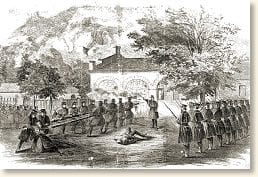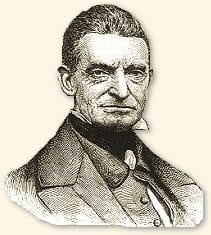Just after sundown on the evening of Sunday October 16, 1859 John Brown led a group of 21 men (16 white and 5 black) across the Potomac River from Maryland to Virginia. Their immediate objective was the capture of the cache of weapons stored at the U.S. Arsenal at Harpers Ferry. Brown’s ultimate goal was to destroy the slave system of the South. The arms captured by the raid would allow Brown and his followers to establish a stronghold in the near-by mountains from which they could attack slaveholders and draw liberated slaves into their ranks.
Brown’s raid attained initial success. Slashing the telegraph wires to cut off the town from the outside world, the raiders captured the local armory, arsenal and rifle manufacturing plant. They then rounded up 60 townspeople as hostages. Unfortunately, the raiders were unsuccessful in their attempt to isolate the town. A B&O Railroad train was detained as it passed through, but allowed to continue on its journey to Baltimore. Once it reached its destination, the alarm was raised and federal troops sent to the rescue. In the meantime, the local militia surrounded the town preventing the raiders’ escape. Realizing his predicament, John Brown led his men, along with nine hostages, to the small fire engine house adjacent to the armory.
Federal forces arrived on Monday evening and successfully stormed the stronghold the following day, seriously wounding Brown. He was tried and convicted of treason against the Commonwealth of Virginia. Just before his hanging on December 2, 1859, Brown uttered a prophetic forewarning of the coming Civil War: “I, John Brown, am now quite certain that the crimes of this guilty land will never be purged away but with blood.”
John Brown’s raid and subsequent trial inflamed the dispute between the country’s abolitionist and pro-slavery factions hardening the lines that separated the North and the South.
“I determined to summon the insurgents to surrender… I did not expect it would be accepted.”
The federal forces that rushed to rescue Harper’s Ferry were led by Colonel Robert E. Lee – soon to become commander of the Confederate Army of Northern Virginia. Lee described the action at Harpers Ferry in a report to his superiors:
“…on arriving here on the night of the 17th instant,I learned that a party of insurgents, about 11pm on the 16th, had seized the watchmen stationed at the armory, arsenal, rifle factory, and bridge across the Potomac, and taken possession of those points.
They then dispatched six men, under one of their party, called Captain Aaron C.V. Stevens, to arrest the principal citizens in the neighborhood and incite the Negroes to join in the insurrection. The party took Colonel L. W. Washington (the great-grand-nephew of George Washington) from his bed about 1 1/2 am on the 17th, and brought him, with four of his servants, to this place. Mr. J. H. Allstadt and six of his servants were in the same manner seized about 3 am, and arms placed in the hands of the Negroes.
Upon their return here, John E. Cook, one of the party sent to Mr. Washington’s, was dispatched to Maryland, with Mr. Washington’s wagon, two of his servants, and three of Mr. Allstadt’s, for arms and ammunition, &c. As day advanced, and the citizens of Harper’s Ferry commenced their usual avocations, they were separately captured, to the number of forty, as well as I could learn, and confined in one room of the fire-engine house of the armory, which seems early to have been selected as a point of defense… These companies forced the insurgents to abandon their positions at the bridge and in the village, and to withdraw within the armory enclosure, where they fortified themselves in the fire-engine house, and carried ten of their prisoners for the purpose of insuring their safety and facilitating their escape, whom they termed hostages…
I determined to summon the insurgents to surrender. As soon after daylight as the arrangements were made Lieutenant J. E. B. Stewart, 1st cavalry, who had accompanied me from Washington as staff officer, was dispatched, under a flag, with a written summons… Knowing the character of the leader of the insurgents, I did not expect it would be accepted. I had therefore directed that the volunteer troops, under their respective commanders, should be paraded on the lines assigned them outside the armory, and had prepared a storming party of twelve marines, under their commander, Lieutenant Green, and had placed them close to the engine house, and secure from its fire. Three marines were furnished with sledge-hammers to break in the doors, and the men were instructed how to distinguish our citizens from the insurgents; to attack with the bayonet and not to injure the blacks detained in custody unless they resisted.”
The Attack on the Engine House
Lieutenant Stewart was also directed not to receive from the insurgents any counter propositions. If they accepted the terms offered, they must immediately deliver up their arms and release their prisoners. If they did not, he must, on leaving the engine-house, give me the signal. My object was, with a view of saving our citizens, to have as short an interval as possible between the summons and attack. The summons, as I had anticipated, was rejected. At the concerted signal the storming party moved quickly to the door and commenced the attack. The fire engines within the house had been placed by the besieged close to the doors. The doors were fastened by ropes, the spring of which prevented their being broken by the blows of the hammers. The men were therefore ordered to drop the hammers, and, with a portion of the reserve, to use as a battering-ram a heavy ladder, with which they dashed in a part of the door and gave admittance to the storming party.

The fire of the insurgents up to this time had been harmless. At the threshold one marine fell mortally wounded. The rest, led by Lieutenant Green and Major Russell, quickly ended the contest. The insurgents that resisted were bayoneted. Their leader, John Brown, was cut down by the sword of Lieutenant Green, and our citizens were protected by both officers and men. The whole was over in a few minutes…
From the information derived from the papers found upon the persons and among the baggage of the insurgents, and the statement of those now in custody, it appears that the party consisted of nineteen men – fourteen white and five black. That they were headed by John Brown, of some notoriety in Kansas, who in June last located himself in Maryland, at the Kennedy farm, where he has been engaged in preparing to capture the United States works at Harper’s Ferry.
He avows that his object was the liberation of the slaves of Virginia, and of the whole South; and acknowledges that he has been disappointed in his expectations of aid from the black as well as white population, both in the Southern and Northern States. The blacks whom he forced from their homes in this neighborhood, as far as I could learn, gave him no voluntary assistance… The result proves that the plan was the attempt of a fanatic or madman, which could only end in failure; and its temporary success was owing to the panic and confusion he succeeded in creating by magnifying his numbers.”
References:
Robert E. Lee’s account appears in: Hart, Albert B., American History Told by Contemporaries vol.4 (1928); Furnas, J.C. The Road to Harper’s Ferry (1961); Nelson, Truman John, The Old Man: John Brown at Harper’s Ferry (1973).
Recommended Books:
 A cultural biography of John Brown, the controversial abolitionist who used violent tactics against slavery and single-handedly changed the course of American history. Reynolds brings to life the Puritan warrior who gripped slavery by the throat and triggered the Civil War. Reynolds demonstrates that Brown’s most violent acts—including his killing of proslavery settlers in Kansas and his historic raid on Harpers Ferry, Virginia–were inspired by the slave revolts, guerilla warfare, and revolutionary Christianity of the day. He shows how Brown seized public attention, polarizing the nation and fueling the tensions that led to the Civil War. Reynolds recounts how Brown permeated American culture during the Civil War and beyond, and how he planted the seeds of the civil rights movement by making a pioneering demand for complete social and political equality for America’s ethnic minorities.
A cultural biography of John Brown, the controversial abolitionist who used violent tactics against slavery and single-handedly changed the course of American history. Reynolds brings to life the Puritan warrior who gripped slavery by the throat and triggered the Civil War. Reynolds demonstrates that Brown’s most violent acts—including his killing of proslavery settlers in Kansas and his historic raid on Harpers Ferry, Virginia–were inspired by the slave revolts, guerilla warfare, and revolutionary Christianity of the day. He shows how Brown seized public attention, polarizing the nation and fueling the tensions that led to the Civil War. Reynolds recounts how Brown permeated American culture during the Civil War and beyond, and how he planted the seeds of the civil rights movement by making a pioneering demand for complete social and political equality for America’s ethnic minorities.
 A New York Times Notable Book for 2011
A New York Times Notable Book for 2011
A Library Journal Top Ten Best Books of 2011
A Boston Globe Best Nonfiction Book of 2011
Late on the night of October 16, 1859, John Brown launched a surprise raid on the slaveholding South. Leading a biracial band of militant idealists, he seized the massive armory at Harpers Ferry, freed and armed slaves, and vowed to liberate every bondsman in America.
Brown’s daring strike sparked a savage street fight and a counterattack by U.S. Marines under Robert E. Lee. The bloodshed and court drama that followed also shocked a divided nation and propelled it toward civil war. Tony Horwitz’s Midnight Rising brings Brown and his uprising vividly to life and charts America’s descent into explosive conflict. The result is a taut and indispensable history of a man and a time that still resonate in our own.
 A moving cultural biography of abolitionist martyr John Brown, by one of the most important African-American intellectuals of the twentieth century.
A moving cultural biography of abolitionist martyr John Brown, by one of the most important African-American intellectuals of the twentieth century.
In the history of slavery and its legacy, John Brown looms large as a hero whose deeds partly precipitated the Civil War. As Frederick Douglass wrote: “When John Brown stretched forth his arm … the clash of arms was at hand.” DuBois’s biography brings Brown stirringly to life and is a neglected classic.



